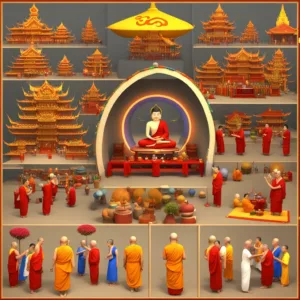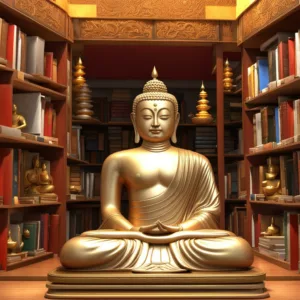Ksanti paramita, of patience, the 3rd perfection means forbearance and forgiveness. Primary traits are abandoning anger, remaining in compassion even for one’s enemies, and not giving up on difficult situations. But how to attain it?
Virya paramita or exertion is the 4th paramita. It quite simply means not giving up on the path of dharma, developing virtue, and benefitting sentient beings. Virya allows the practitioner to complete their dharmic goals. Is it achievable?

Table of Contents
What are the 6 paramitas of Mahayana Buddhism?
| 6 Paramitas Transcendent / perfected Virtues | |
| Sanskrit / Pali | English |
| Dana paramita | Transcendent Generosity |
| Sila, Shila paramita | Transcendent discipline, moral character |
| Kshanti, ksanti paramita | Perfect Patience |
| Virya paramita | Perfect Exertion |
| Dhyana paramita | Perfect Meditation |
| Prajna paramita | Transcendent Wisdom, insight |
Ksanti Paramita: Patience

Ksanti (kshanti) or patience paramita is a sort of mountain pass in the paramitas. Attaining patience brings one halfway through. Patience is said to be the hardest paramita to attain. As a bodhisattva, the Buddha worked on patience for 50,000 lifetimes.
Putting aside this possible hyperbole, patience is indeed difficult. We have an incomplete image of patience, that it is waiting for something without annoyance or frustration – peacefully waiting. In that case, someone could enter samadhi or find some other active dharmic way to occupy the mind. One could contemplate patience itself, the act of developing patience and taking on others’ impatience in order to develop patience.
However, there is a different angle to patience that is more fruitional. It is to Not Give Up on a situation. It is also to not rise easily to anger. The paramita would be to never give rise to anger, no matter the situation.
Ksanti paramita means Enduring, Tolerance, Forbearance
Patience is continuing to work with difficulties – be they people or otherwise. Transcendent patience is the joy in working with difficult situations and obstacles. One knows there is a purification and a releasing process happening. Ingrained habits are being loosened and eroded, replaced by freedom habits. One is not being tightly attached to specific outcomes but working to release long-standing neurotic obstacles – irritations and aggravations and so forth.
Obstacles which test one’s patience are seen as joyful arisings to work on the paramitas. Perfection of patience is taking that to an even greater place where it is delightful simply to engage with the obstacles with no sense of even trying to develop anything. Just working with challenges is the point all by itself.
Lojong Slogans for Kshanti paramita
Point Three: Transformation of Bad Circumstances into the Way of Enlightenment
- When the world is filled with evil, transform all mishaps into the path of bodhi.
- Drive all blames into one.
- Be grateful to everyone.
- Seeing confusion as the four kayas is unsurpassable Śūnyatā protection. Dharmakaya, sambhogakaya, nirmanakaya, svabhavikakaya. Thoughts have no birthplace, thoughts are unceasing, thoughts are not solid, and these three characteristics are interconnected.
- Four practices are the best of methods. The four practices are: accumulating merit, laying down evil deeds, offering to the dons, and offering to the dharmapalas.
- Whatever you meet unexpectedly, join with meditation.

Flow, the profound mental state, also called Peak Performance, can be attained with meditation and can be ‘triggered’ at will, with enough discipline. Guide to Flow Mastery will teach you how.
Virya Paramita: Exertion or Tsondru
Exertion is also called diligence and joyful effort. Slightly tongue in cheek, it could be said to be the most important paramita. If you attain transcendent exertion, you will never give up, therefore you will eventually attain your goal given sufficient time.
Never give up. Never, ever give up.
Chokyi Gyatso, the 11th Trungpa Tulku
The path is difficult. It’s easy to become discouraged, but if you have genuine exertion, if you know that discouragement cannot stop you, you will not ever give up under any circumstances. You may feel tired and want to stop, but you can refresh yourself through a meditative retreat or accumulation of merit, a good night’s sleep, time with your teacher or sangha friends, or whatever is needed. You do that to revitalize yourself to continue on the dharmic journey.
Energy, persistence, perseverance, and vigor are other descriptions of virya. It can also mean great strength or heroism. Virya is invoked frequently in the dharma, even considered an indispensable aspect for liberation.
You must work out your own salvation with great virya, Ananda. I can only show you the way.
Buddha Shakyamuni, shortly before passing
Another concept akin to virya is lungta. Lungta, translated as windhorse or the wind of suchness, is a multivariate aspect of the path and a key source of energy for the practitioner. It consists of having strong purity, vision, unerring goals on the path, and constantly generating a dharmic outlook.
Virya-paramita, or transcendent exertion, is knowing you will continue without ceasing, for endless time. It is taking immense joy in that because the task of traveling the path of dharma, pursuing truth and reality, and helping others to liberation is so powerful and meaningful that anything else simply disappears into naught. But the path remains because it is the path to the abiding truth, beyond all definitions, beyond Buddhism or any single tradition. It is self-existing, beyond all change, or else it would not be the ultimate reality.
Lojong slogans for Exertion
Point Four: Showing the Utilization of Practice in One’s Whole Life
- Slogan 17. Practice the five strengths, the condensed heart instructions. The 5 strengths are: strong determination, familiarization, the positive seed, reproach, and aspiration.
- Slogan 18. The Mahāyāna instruction for ejection of consciousness at death is the five strengths: how you conduct yourself is important. When you are dying practice the 5 strengths.
Secrets of Meditation for Anxiety
Like millions of people, you may have suffered from anxiety for years. Meditation, yoga, peaceful music – it never works. It takes too long, and it’s not stable. Why? Because peace is treated as a cause for freedom, but it’s not – it’s the result. The cause to free yourself from anxiety is completely different.
Click now to Overcome Anxiety for good.
Conclusion
The 3rd and 4th paramitas of patience and exertion form a mighty combination for relating to obstacles. When combined with the non-attachment and letting go of dana, generosity, and karuna, compassion of ethical discipline, these four create a full system to accumulate vast merit, or fuel for the path. This merit can be sealed (as the final block of this post does) by giving it away a la generosity for the benefit of beings. Then it can never be lost.
From that point it becomes the gateway to wisdom, which is the province of the last two paramitas – dhyana, meditation, and jnana, wisdom.
faq
What is the kṣānti paramita?
Ksanti paramita, the 3rd paramita is the perfection of patience, or transcendent patience.
Is prajnaparamita a buddha?
Prajnaparamita is a Buddha manifesting as a female deity in the Vajrayana. Her 4 hands hold a text, a dorje, and make the teaching mudra. Prajnaparamita also means the perfection of knowledge or wisdom.
What is the meaning of the word paramita?
Paramita means perfection, transcendence, or the other shore.
What is the paramita of enthusiasm?
The paramita of enthusiasm is also called exertion, vigor, energy, or in Sanskrit Viryaparamita.
Why are the 6 paramitas important?
The 6 paramitas are important because they form the framework of the bodhisattva path.
What language is Paramita?
Paramita is Sanskrit or Pali for Transcendent Virtue or Perfection.
What is the paramita of joyful effort?
Viryaparamita, exertion is the paramita of joyful effort.








